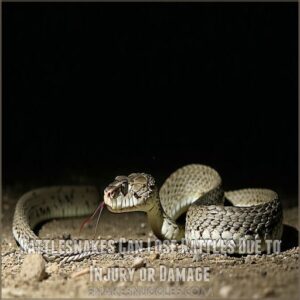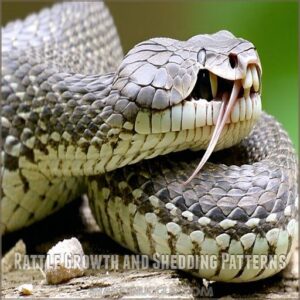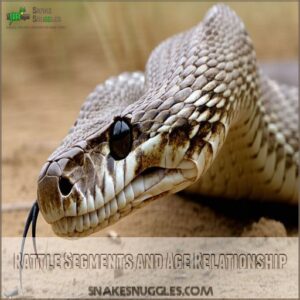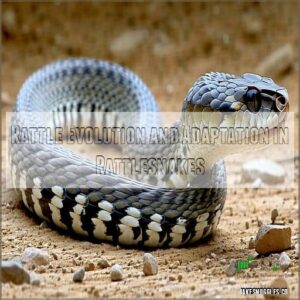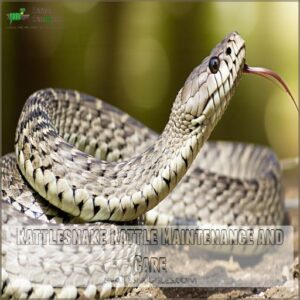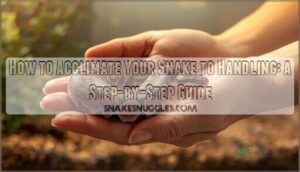This site is supported by our readers. We may earn a commission, at no cost to you, if you purchase through links.
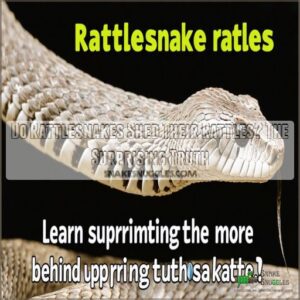
Rattlesnakes shed their skin and, with each shedding, they tack on a new segment to their rattle.
However, the rattle itself doesn’t shed. It’s like collecting charms on a bracelet—you just keep adding more.
But life in the wild isn’t easy, and rattle segments can break off. Sadly, they don’t grow back, so if one snaps, that’s it.
Think of a rattlesnake’s rattle like a natural alarm system, important for survival.
Curious about how these segments form and what they say about age? You’re not alone!
Table Of Contents
- Key Takeaways
- Rattlesnake Rattle Biology
- Do Rattlesnakes Shed Their Rattles
- Rattle Growth and Shedding Patterns
- Rattle Segments and Age Relationship
- Rattle Function and Purpose in Rattlesnake
- Rattle Evolution and Adaptation in Rattlesnakes
- Rattlesnake Rattle Maintenance and Care
- Frequently Asked Questions (FAQs)
- How does a rattlesnake shed?
- Do rattlesnakes shed or molt?
- Do rattlesnakes grow back?
- How many times can a rattlesnake shed?
- Do rattlesnakes break off as they age?
- Why are rattlesnakes losing their tails?
- How often do rattlesnakes shed their rattles?
- Can rattlesnake rattles break off?
- Do rattlesnake rattles grow back?
- How old is a rattlesnake with 12 rattles?
- Conclusion
Key Takeaways
- You might think rattlesnakes shed their rattles entirely, but they actually add a new segment each time they shed their skin.
- Don’t rely on counting rattle segments to guess a rattlesnake’s age; shedding frequency varies based on food and environment, not age.
- Rattles are made of keratin segments that interlock, but once a segment breaks off, it cannot grow back.
- The rattle serves as a vital alarm system, helping snakes deter predators and avoid wasting venom on unnecessary threats.
Rattlesnake Rattle Biology
Imagine your fingers tapping out a rhythm on drums—now picture a rattlesnake doing the same with its tail, using hollow keratin segments that interlock to create a signature shake.
These unique rattles vary in size and sound across species,
turning the desert floor into a snake’s personal stage full of vibrant performances.
Composed of Hollow, Interlocked Keratin Segments
Rattlesnakes sport rattles composed of hollow, interlocked keratin segments—imagine a tough, organic chain. These segments are fragile yet essential for effective rattling. Crafted from keratin, like your nails, they’re designed to last but can break with time. Each piece plays its part, warning predators away.
- Keratin composition: Like fingernails.
- Segment function: Warning system.
- Rattle fragility: Prone to damage.
- Rattle growth: Adds segments over time.
Vibrates When Tail Muscles Contract
Ever wonder how rattlesnakes make that iconic sound?
It’s all about their rattle muscle function.
When these muscles contract, the rattles shake, creating vibrations that can reach astonishing speeds.
Imagine shaking your foot that fast!
This rapid frequency helps them sound alarms and provides a survival edge in the wild—a fascinating example of animal adaptation and control in nature.
Different Species Have Varying Rattle Sizes and Sounds
Picture yourself walking through a sunlit trail, when a distinct buzz suddenly catches your ear.
You know, different rattlesnake species come with their own rattle sizes and sounds, shaped by their environment.
This diversity is like nature’s quirky orchestra.
Whether it’s a deep growl or a high-pitched buzz, rattles vary due to geographic variations and evolutionary quirks.
Fascinating, right?
Do Rattlesnakes Shed Their Rattles
So, you’re wondering if rattlesnakes shed their rattles like they shed their skin?
Well, they don’t exactly shed them whole,
but each time a snake molts, it adds a new segment to its rattle – think of it as a segmented, bony souvenir of each successful shed.
Rattlesnakes Can Lose Rattles Due to Injury or Damage
Although you might think rattlesnakes hold onto their rattles like prized possessions, life’s bumps can lead to rattle loss.
Whether it’s a tussle with a curious predator or an unlucky scrape with tough terrain, these keratin segments sometimes break off.
Injured snakes may face challenges, but thankfully, rattle damage isn’t typically a threat to their health or survival.
New Segment Added With Each Skin Shed
Every shedding brings a new beginning for rattlesnakes.
With each slough of their skin, a brand-new segment is added to their rattle, like adding a bead to a necklace.
It’s nature’s way of showing growth, even if these segments won’t reveal the snake’s age.
So, the next time you hear a rattle, you’re listening to a history being slowly pieced together.
Rattles Do Not Grow Back if Broken Off
Losing a rattle is a tough break for rattlesnakes—literally.
Once a rattle breaks off, there’s no rattle regeneration.
This permanent loss impacts how they communicate danger.
Think of it like losing your car horn!
Regular rattle care helps, but if a snake does lose one, it can’t repair or regrow.
Nature’s reminder to tread carefully!
Rattle Growth and Shedding Patterns
You might be surprised to learn that young rattlesnakes shed their skin—and add to their rattles—more often than their older relatives, sometimes up to four times a year when it’s warm.
Shedding frequency depends on how often they find food, so a well-fed snake might flaunt a bigger rattle sooner!
Faster Shedding in Younger Snakes
Young rattlesnakes, like teenagers with a growth spurt, shed their skin more often, making their rattle growth rates faster.
As a result, they may require products to aid in their shedding process, such as those found at young rattlesnake shedding supplies.
Shedding frequency is influenced by their active metabolism and higher energy needs.
With each shed, the rattle gains a new segment.
This process is tied to prey availability, as more food means more growth spurts for these baby snakes.
Sheds 3-4 Times a Year in Warm Months
When it gets warm, rattlesnakes start shedding like they’re trying to keep up with the summer sun.
As they shed, a new rattle segment forms at the base of the tail with each skin shed, which is a result of their rattle growth pattern.
Picture them slipping out of their old skin 3-4 times a year—a pretty neat trick for stepping up their growth game.
This shedding frequency isn’t just for show; it’s a key part of their rattlesnake cycle and health routine.
Shedding Frequency Influenced by Prey Availability
Regularly, a rattlesnake’s shedding frequency hinges on its food supply.
Prey scarcity slows growth and shedding; food abundance speeds things up.
Think of it like this: a well-fed snake sheds more often, while a hungry one conserves energy.
This seasonal impact on shedding rate directly affects rattle growth.
A healthy snake with plenty of prey will have more rattles, faster.
Rattle Segments and Age Relationship
You might be tempted to count a rattlesnake’s rattle segments to guess its age, but it’s as reliable as using shoe size for a birthday estimate.
When rattlers make their grand entrance into the world, they start rattle-free and get their first buzz-worthy segment only after shedding their skin for the first time.
Cannot Determine Age by Number of Rattles
Ever wonder if you can tell a rattlesnake’s age by its rattle?
Unfortunately, it’s not that simple!
Think of rattles as more of a snake’s life diary, not a birthday cake with candles.
To better understand this, you can find products and tools online, such as those related to rattle snake shedding.
Snakes’ rattles:
- Break due to environmental factors
- Vary in growth rate
- Reflect shedding frequency
- Don’t indicate overall lifespan
Got it?
Newborn Rattlesnakes Have No Rattle
Imagine this: newborn rattlesnakes, fresh into the world, don’t come with their iconic rattles.
It’s like heading to a rock concert without the band!
These tiny serpents rely on instinct rather than noise for early survival.
The rattle formation development process starts later, where keratinization begins at the distal lobe and progresses inward, as explained in rattlesnake rattle formation.
Here’s a quick look:
| Aspect | Details |
|---|---|
| Rattle Present? | No |
| Primary Defense | Camouflage, Quick Reflex |
| Rattle Status | Develops Later |
Understanding these little critters adds a layer to snake behavior, doesn’t it?
First Rattle Segment Added After First Skin Shed
Once a newborn rattlesnake sheds its skin for the first time, it gets its initial rattle segment.
Imagine it like a badge of honor earned through that inaugural shed.
This tiny piece marks the start of rattle development, a process as fascinating as it’s essential.
Each new segment signifies growth, much like celebrating a milestone on life’s journey.
Rattle Function and Purpose in Rattlesnake
You know that iconic rattle sound, right?
It’s not just for show—it scares off predators, warns others to back off, and cleverly conserves the snake’s energy by preventing unnecessary skirmishes.
Scares Off Predators
So, you can’t tell a rattlesnake’s age by counting its rattles.
But those rattles? They’re a pretty effective rattlesnake defense mechanism!
That loud buzzing noise is a rattlesnake warning, a clear signal to potential predators: "Back off!"
It’s all about rattlesnake survival – a built-in alarm system to avoid becoming someone’s lunch.
Think of it as nature’s built-in burglar alarm.
The rattle’s main job is to scare off predators before things get messy.
Warns Other Creatures to Stay Away
Ever think about how rattlesnakes get others to keep their distance?
Their rattle’s a clever tool in their survival toolkit.
It’s like the ultimate "stay away" sign, warning predators and curious creatures alike that crossing paths isn’t wise.
This snake communication method boosts the rattlesnake’s chances of a peaceful day, showcasing nature’s ingenious way of enforcing territorial defense.
Protects Rattlesnake From Venom Waste or Injury
Think of a rattlesnake’s rattle like a superhero’s shield—it’s all about self-protection.
By rattling, snakes steer clear of venom waste and injury, saving their precious toxin for real threats.
This clever defense mechanism warns off predators, ensuring they’ve got enough venom left when it truly counts.
It’s not just noise; it’s nature’s insurance policy.
You can even find various products inspired by the rattlesnake rattle online, such as those at rattlesnake rattle items.
Rattle Evolution and Adaptation in Rattlesnakes
Okay, imagine you’re strutting along the Great Plains, and rattlesnakes have turned their rattles into fancy warning buzzers just to avoid getting squished by stampeding hooves.
This neat adaptation keeps them safe and also cleverly saves precious energy and venom for more important snake business.
Evolved on Great Plains to Avoid Trampling
Picture rattlesnakes shaking their rattles like tiny maracas, not just for show but for survival on the vast Great Plains.
Over time, these snakes adapted to avoid becoming accidental pancakes under hooved animals.
This isn’t random clattering—it’s a dance of evolution, perfectly tuned to the rhythms of nature.
Such clever tactics reflect rattlesnake evolution in wild ecosystems.
Sharp Buzz Alerts Hooved Animals
A rattlesnake’s sharp buzz isn’t just noise; it’s a savvy survival tool.
Imagine hoofed animals, like deer or cattle, meandering the plains.
That buzz does three things:
- Alerts them to potential danger, preventing trampling.
- Commands respect, warding off threats.
- Establishes a distinct presence in its habitat.
These snakes know how to stay safe!
Conserves Energy and Venom
Imagine chilling out under a tree.
Rattlesnakes do something similar, using their rattles to conserve energy and venom. By shaking their tails, they warn predators and avoid unnecessary fights, letting them save precious energy for hunting.
Their unique heat-sensing loreal pits, which provide infrared vision abilities, are essential for their stealth and hunting prowess.
Here’s how they balance it:
| Strategy | Purpose | Result |
|---|---|---|
| Rattling | Predator avoidance | Energy conservation |
| Coiling | Defense | Venom saving |
| Hiding | Camouflage | Stealth hunting |
| Striking | Only needed | Venom usage |
| Basking | Warmth upkeep | Metabolism boost |
Rattlesnake Rattle Maintenance and Care
So, you’re curious about rattlesnake rattle maintenance?
It’s less like a car wash and more about understanding how these amazing segments break off naturally, affecting a snake’s warning system and even its lifespan in the wild—or how captive snakes often sport impressively long rattles!
Importance of Rattle Maintenance for Survival
Keeping your rattlesnake’s rattle in top shape isn’t just for show—it’s vital for its survival.
The rattle’s integrity guarantees effective predator deterrence, making sure wannabe threats think twice.
It conserves venom by scaring off rather than striking.
Healthy rattles also aid in hunting efficiency.
So, while nature doesn’t send rattlesnake maintenance reminders, it’s their ticket to thriving.
Rattles Can Break Off in The Wild
Out in the wild, rattlesnakes face all sorts of rough and tumble adventures.
It’s pretty common for their rattles to break off due to injuries or scuffles.
This loss impacts their ability to warn off danger, leaving them vulnerable.
Unlike nails, they won’t regenerate.
So, next time you’re trekking, remember a snake’s broken rattle might mean it’s been through a wild ride.
Captive Snakes Often Have Longer Rattles
In the wild, rattles can easily break off, making longer ones rare. However, captive snakes often boast longer rattles, like badges of their stress-free life. Why?
- Captive snake diets are typically rich and consistent.
- Lower rattle breakage rates occur with fewer obstacles.
- Reduced stress from predators or harsh environments.
- Frequent rattle growth due to consistent shedding.
Frequently Asked Questions (FAQs)
How does a rattlesnake shed?
When a rattlesnake sheds, it’s like shedding an old coat to reveal a vibrant new one!
They shed their entire skin, not just the rattle, adding a new segment with each molt, keeping them sleek and stealthy.
Do rattlesnakes shed or molt?
Rattlesnakes don’t shed their rattles like a lizard sheds its skin.
Instead, they add a new segment each time they shed their skin.
Think of it like adding a new train car to the back of a snake-train!
Do rattlesnakes grow back?
You might wonder if a rattlesnake can regrow its rattle, but the answer is no, it doesn’t grow back in the classical sense,
though new segments are added with each skin shed, lengthening the rattle.
How many times can a rattlesnake shed?
Did you know rattlesnakes might shed their skin four times a year?
Each shed adds a new segment to their rattle, but only if it doesn’t break off in the wild.
It’s Mother Nature’s own little puzzle!
Do rattlesnakes break off as they age?
As rattlesnakes age, their rattles can break off naturally.
Each shed adds segments, so longer rattles are typical in captivity.
In the wild, segments wear and tear quicker, making intact rattles less common.
Keep an eye out!
Why are rattlesnakes losing their tails?
Picture losing your favorite hat, not the whole head.
Rattlesnakes aren’t losing their tails; their rattles break off naturally over time.
Frequent shedding adds new segments, while older ones may drop during their rugged life.
How often do rattlesnakes shed their rattles?
Rattlesnakes don’t shed their rattles like skin; each shed adds a new segment.
How often they shed depends on how often they eat, so it varies!
Think of it like adding rings to a tree trunk.
Can rattlesnake rattles break off?
Yes, rattlesnake rattles can definitely break off, especially in the wild.
Think of them as nature’s maracas; they can lose segments if they’re snagged on something or just from regular wear and tear.
Do rattlesnake rattles grow back?
Rattlesnake rattles don’t grow back once they’ve broken off.
Imagine losing the noisemaker from your bicycle—but don’t worry, each time snakes shed, a new segment forms, adding back to the rattle’s length over time.
How old is a rattlesnake with 12 rattles?
Counting rattles is like counting birthdays, but don’t be fooled.
A rattlesnake with 12 rattles isn’t necessarily 12 years old.
Shedding varies with food and environment, so those segments mark growth, not exact age.
Conclusion
Regarding rattlesnake rattles, “don’t judge a book by its cover.”
While snakes don’t shed their rattles, each shed adds a new segment, much like adding charms to a bracelet.
This natural alarm system warns predators and signals age, though segments break and don’t grow back.
Understanding this, you can appreciate how rattlesnakes adapt over time.
So next time you hear a rattle, remember it’s more than noise; it’s a survival strategy.




